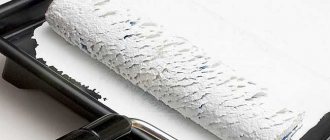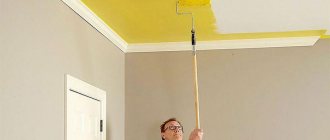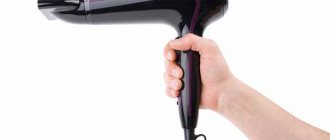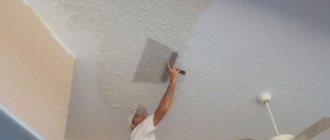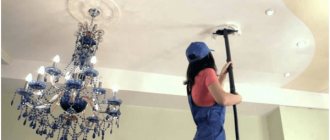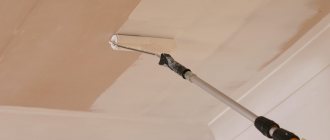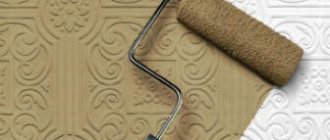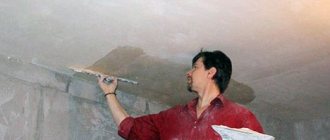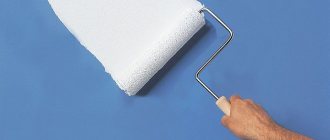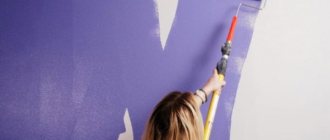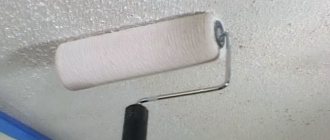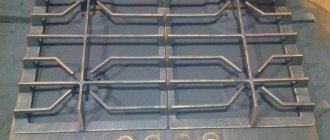Painting experts
When repairing old
The owner of these premises has a question about whether it is possible to paint with water-based paint over whitewash, what is needed for this, how to do the work correctly so that the old plaster does not fall off the walls and ceiling.
Experts advise to first get rid of the whitewash and then start painting, but you must take into account that when washing the plaster a lot of dust will accumulate, so you will need polyethylene to pre-cover the surfaces to be treated before work.
Is it possible to paint the ceiling surface after whitewashing?
Until recently, all problems with finishing ceilings were solved quite simply. They were whitened using chalk or lime mortar. This operation was performed without any problems, and in a fairly short time. A little later it became fashionable to paint ceiling tiles with water-based paint. This finishing option remains quite in demand today. At the same time, many home craftsmen are literally perplexed by the question of whether or not it is possible to paint a previously whitewashed ceiling. There is one answer to this. The ceiling can be painted after whitewashing. But subject to certain conditions.
Painting the ceiling after whitewashing
Painting with water-based emulsion is allowed when the whitewash layer is thin and adheres well to the ceiling.
In this situation, you can safely paint the surface without removing the old finishing layer. If the whitewash does not hold firmly, regularly crumbles, water streaks and traces of rust are clearly visible on it, it is not recommended to use paint to decorate the ceiling. You must first thoroughly clean the surface of the old coating and only then use water-based emulsion. In cases where the whitewash lies in an even and beautiful layer that is thick, experts advise removing this coating. If this is not done, some time after painting with water-based paint, the beautiful layer of whitewash will begin to crumble and peel off. As a result, all the finishing will become unusable. And you will have to decorate the ceiling again.
How to remove whitewash from the ceiling
Whitewash is the most “water-soluble” finishing option, so we wash it off with water. It’s troublesome, dirty, wet, but there’s no other way out. The steps for cleaning a whitewashed ceiling are simple.
- Wet the surface with hot water – generously, two or three times. Here you can use a brush, a roller, and a spray gun (or another sprayer).
- We give the whitewash layer time to swell - this will take 15-20 minutes.
- We clean off the peeling layers with a spatula.
- We wash off the remaining whitewash with a hard cloth (for example, an old terry towel). Rub vigorously and rinse the cloth regularly.
Painting the ceiling with water-based paint - 7 steps
So, if the whitewash holds tightly, we proceed to painting. First, carefully stir the purchased water emulsion. For these purposes, we use a suitable stick or (which, of course, is better) a special attachment on a construction mixer. The paint is sometimes slightly diluted with water (provided that the manufacturer of the composition allows this possibility).
Roller for painting the ceiling
After this, the mixed composition is poured into a container with a grooved side. Such baths cost pennies and are sold in any construction supply store. You are all ready to paint the ceiling surface with water-based paint. The operation is performed like this:
- Dip the paint brush into the container with the prepared composition, squeeze (lightly) the tool on the grooved side.
- Paint the perimeter of the ceiling twice (the areas where the ceiling and wall surfaces meet).
- Shade the painted part with a semi-dry brush (there should be a minimum of paint on it).
- Take a paint roller. Dip it into the bath and then be sure to roll it out along the grooved side of the container.
- Apply a thin layer of paint with a roller. The movements of the tool should be directed perpendicular to the light rays coming from the window opening.
- Wait 7–8 hours for the first layer of water-based paint to dry.
- Apply the next layer. Now you need to paint the ceiling parallel to the rays of light.
That's all the wisdom of treating a whitewashed ceiling with water-based paint. Note that we have presented a universal method of painting surfaces. With different types of water-based emulsion (more on this below), sometimes you need to work according to individual schemes. The specific method of using the paint is always indicated in the instructions supplied with it. Please take the time to read this important information.
Useful tips for home craftsmen for impeccable results
Painting ceiling surfaces can be done not only with a roller and brush. If desired, use a spray gun if you know how to use it. Also, many craftsmen adapt old vacuum cleaners for these purposes, turning them into original spray guns. Some craftsmen advise treating the ceiling with a primer before applying paint. There is no particular need for this. The water-based emulsion itself acts as a primer. Why complicate the work? If the whitewash adheres poorly to the ceiling, no primer will make it more durable. The old finishing layer should always be removed from crumbling ceilings. In other cases, feel free to apply paint without washing off the whitewash.
About the types and characteristics of water-based compositions
You can buy different types of water-based emulsion in construction stores and markets. According to their composition, they are: silicone, acrylic, silicate, latex. There are no fundamental differences between them. They differ from each other only in that ceilings painted with certain compounds (for example, latex or acrylic) can be washed. In addition, latex-based paints do a good job of closing small gaps on ceiling surfaces. But the cost of such compositions is very high.
All water-based paints have a number of advantages. They are very practical, easy to apply with your own hands, hypoallergenic and completely safe for health. It is also important that modern water-based emulsion can have almost any color shade. Finally, let’s say that the paints described in the article are divided into glossy, matte and semi-matte. If you are painting a whitewashed surface without washing off the previous finishing layer, do not use a glossy compound. He will not be able to mask all the unevenness of the ceiling. But matte paints are ideal for painting whitewashed substrates.
Previously, ceilings were most often finished with whitewash, but now this look is not a priority. Therefore, now everyone covers the whitewash with other materials. If you are planning to paint, is it possible to paint the ceiling after whitewashing? We will deal with this in the article below.
In what cases is it better not to paint the ceiling and walls over whitewash?
Do not paint with water-based paint over uneven whitewash.
The demand from specialists to dismantle the old coating in most cases is not caused by a desire to complicate life or add work, but by the need to protect people from future problems.
Pay attention to: How to remove paint from jeans
A whitewashed ceiling and walls, after treating them with water-based or acrylic paint, may simply lose their attractiveness, since under the lime coating the condition of the base, which has various defects, such as cracks and chips, depressions, is not visible.
When painting whitewashed surfaces, deformation of the new coating is possible due to unevenness of the old layer. The whitewash gets wet under the influence of the absorbed paint and then becomes sticky. In this case, lime sticks to the roller or brush and is then spread over the surface to be treated.
In addition, you will have to wash off the old whitewash in the following cases:
- There is a thick layer of plaster on the ceiling and walls. Due to its hygroscopicity, it will absorb paint, then swell, crack and collapse. In this case, the paint will bubble and become covered with cracks.
- If there are traces of leaked water on the surfaces being treated, then the paint, despite the selection of colors and textures, will stand out sharply in these places. Any attempts to correct the situation will not be successful.
- Old walls and ceilings have defects such as microscopic cracks and pits. Painting such a surface will sharply highlight these imperfections. Therefore, first you will have to work with a spatula and putty.
- Traces of mold and fungal infection appear. If you paint over them, these simple organisms quickly spread over all surfaces. Therefore, when this danger is identified, it is necessary not only to wash off the whitewash, but also to treat the room with antiseptics.
- The old coating begins to crumble spontaneously. Adding paint will speed up this process.
If at least one of these factors is identified before starting the repair, you will have to remove the old lime and then start painting.
Features of water-based paint
Water-based paint is significantly different from other types. It dries much faster. The fastest drying paint takes only two hours. The water emulsion will not cause harm to health; it contains no toxic substances. You can work without a mask; there is no need to close the room until it dries completely. Due to the absence of harmful substances, the paint has no odor.
There is no need to ventilate the room after this.
- The choice of colors is unlimited. Using a color scheme, you can make the shade you want yourself. The paint is sold primarily in white form.
- The paint is easy to apply and anyone can do it themselves. The water emulsion will serve you for 15 years without shedding. At the same time, it is inexpensive.
- There are also disadvantages to water-based emulsion. The operating temperature should not be below 5 degrees. Painting is possible only in the warm season or in a heated room.
- The paint does not like direct mechanical influences; over time it will wear off and be washed off due to frequent cleaning. She doesn't really like water.
Water-based paint for whitewash
In order to evenly paint surfaces over old whitewash, it is recommended to treat the ceiling and walls with a primer before applying the base layer. This can be ceiling paint diluted in water at least 5 times. If high quality work is required, then it is advisable to purchase a special primer mixture that will ensure normal adhesion of whitewash and water-based paint.
For this purpose, compositions such as ST17 are used. Such primers prevent delamination of whitewash and eliminate its cracking.
After this work, water-based paint will adhere well to the whitewash. Any type of dye of this class that is non-toxic is suitable. To ensure that the new coating does not stand out, it is advisable to consult a specialist when choosing a paint color. Most often they purchase the option with a matte tint. This allows you to better hide minor coating defects.
Please note: Painting chipboard
Types of water-based paint
Water emulsion is divided into 4 types according to composition: acrylic, silicone, silicate, mineral. Some will cost more, others will cost less. Let's take a closer look at them.
Acrylic paint. It is used most often, but therefore it is not cheap. It has the highest quality set of characteristics. Suitable for painting inside and outside. Due to the acrylic content, the paint is waterproof.
It can be washed without risk of abrasion and used in rooms with high humidity. It is the easiest to apply; it does not absorb into the surface. If the paint contains latex, it can cover small cracks. Acrylic paint is not subject to fading: the sun is not afraid of it. At the same time, it is safe and does not emit unpleasant odors: you can paint a nursery or kitchen.
How to paint a ceiling with water-based paint over whitewash
It is still not recommended to apply paint to whitewash. It must first be removed. Painting over whitewash is possible only if it is in perfect condition: if it does not crumble or crack. Try running a clean roller over it. If the whitewash does not remain on the roller and does not begin to fall off, then you can paint directly on it.
If the whitewash is swollen or cracked, then you cannot apply paint to the whitewash. Otherwise, it will begin to crumble right in the process of work. The paint will lie unevenly, and your ceiling will be hopelessly damaged.
If you still plan to apply paint to the whitewash layer, then all you need to do is simply prime the surface of the ceiling. After this, try to disturb the surface again, and if there are no falls, then go to work.
In what cases can the whitewash from the ceiling not be removed?
Find out how tightly the whitewash actually adheres to the base. To do this, moisten the ceiling surface moderately with water with a brush or roll it a couple of times with a roller. You should not wet it too much - this will inevitably lead to peeling of the old finish. If, after moistening, no blisters form on the ceiling, the whitewash layer is durable.
Find out what material was used for whitening. If it is chalk, then you can skip the work of removing it. But painting over lime is a thankless task. It’s easy to determine the material: take a piece of a rag/rag and drag it across the surface, applying a little force. Chalk will stain a cloth, but lime will leave it clean.
But even if the ceiling is still chalky whitewash, the ceiling before painting (walk it with sandpaper), and if it is in the kitchen, then degrease it.
Ceiling preparation
The first thing you need to do when working with paint is to remove all the furniture. Of course, you can cover it with film, but there is no guarantee that there are no holes in it or that it will not tear. It's better to endure everything. When working, use gloves and a mask. Lime is not good for health.
Whitewash is easier to remove when wet. Use warm soapy water. Apply it around the entire perimeter of the ceiling. Change the water when it gets dirty. Treat the entire ceiling thoroughly.
If you have a thin layer of whitewash, then when soaked, you can remove it with a regular roller. Also moisten it periodically with water. Instead of a roller, you can use a brush. For ease of work, you can use a spray bottle and wet the ceiling with it, and remove the coating with a sponge.
If the whitewash is not removed in this way, you will have to work with a spatula. Use it to scrape off the whitewash from the ceiling.
Another way to remove it is with a paste. It simply sticks to the whitewash and, after drying, turns into a film that is easier to peel off. You can make the paste yourself. Add flour or starch to boiled water. Stir gradually to prevent the formation of lumps. Cool the mixture slightly and apply it to the ceiling with a roller or brush, spreading evenly. Then wait until the mixture dries and forms a crust. Remove it with a spatula.
If this does not help, the whitewash can only be removed with a sanding machine. There will be enough drinking, so close the door and put on a protective suit. Then you will need to thoroughly clean the entire room. Preferably several times with special means.
And the most radical way of getting rid of it is removal with acid. You need to work with full protection: glasses, mask, gloves and suit. Add acetic acid in small portions to water. There should be no more than 3% acid per volume of water. The order is exactly this: water, then small portions of acid, otherwise it will react. Apply the solution to the ceiling with a brush and then remove the coating with a spatula or brush. The ceiling surface must be washed with soapy water.
Is it possible to paint over whitewash
There is no prohibition on painting old plaster. Water-based emulsion is easily applied to whitewash using a roller or spray gun. But how long the paint will last on the plaster depends on the quality of the old coating.
Therefore, when renovating an apartment, many owners prefer not to undertake such work, but choose the following alternative options:
- installing suspended ceilings in an apartment over whitewash allows you not to modernize the old surface;
- Various plastic panels are introduced into the design of the kitchen and other auxiliary rooms, which are separated from the old lime at some distance.
But if a person does not have the opportunity to use modern repair methods, then all that remains is to use paints.
Then you must first make sure that there is a thin layer of whitewash on the ceiling and walls. Then the surfaces are examined for the presence of defects, cracks, and various stains. If all this is missing, then you can start painting without washing off the lime. The same actions must be performed if it is decided to use a water-based composition after whitewashing. You just need to wait for the applied lime to dry.
Painting the ceiling
Before application, you need to add color. The main difficulty is to dilute at once as much as is needed for coating, otherwise it will be very difficult to get exactly the same color.
Pour some paint into a measuring container. Inject the color through the syringe. It is important to use measuring containers, since these measurements will guide you when adding color to the main container. Remember your results and calculate how much color you need for the volume of your paint bucket. After you have mixed them, try spreading a little on a small area and see if it is the color you want.
The instructions for the paint describe in detail how and in what quantities to dilute it. The paint is mixed before application and water is added. The composition is mixed and poured into the paint bath. Periodically dip the brush into the bath and wipe off any excess. So paint the entire ceiling. If your finish has absorbed a lot of paint, apply a second coat.
Preparing the ceiling for painting
To achieve the best quality and long service life, it is strongly recommended that before painting with any type of paint, remove as much of the whitened layer as possible and carry out work to eliminate minor irregularities, depressions or scratches. This process is not as complicated as it might seem at first glance.
The ceiling, like any other surface, must be prepared before painting.
For high-quality surface cleaning, you can use two main methods:
- wet processing;
- dry processing.
Dry ceiling cleaning
When dry cleaning, the following tools are often used:
- grinder with grinding disc;
- electric drill with brush attachment;
- Grinder;
- sandpaper.
The dry cleaning process is carried out quite quickly, however, it has several significant drawbacks, due to which it is used extremely rarely.
Dry cleaning is fast, but problematic
- The main disadvantage is the large amount of dust. If work is carried out in only one room, then the room must be carefully insulated while ensuring good ventilation.
- This method is harmful to health; it is necessary to use personal protective equipment in the form of a respirator and goggles.
Video on how to remove whitewash from the ceiling:
Wet cleaning of the ceiling
With wet processing there is much less dust, and the method itself is much safer, however, it takes more time.
To work you will need:
- respirator;
- a small sharpened spatula;
- metal brush;
- roller with medium length pile;
- bucket with water;
- spray.
Before painting over whitewash, its base layer is removed as much as possible by wetting the surface of the ceiling using a conventional roller or spray nozzle. You need to wet a small area as large as you can handle before it dries completely. After applying the washing liquid, you need to wait a little more than half an hour and begin removing the previous layer with a spatula.
It is not recommended to wet more than you can handle before drying.
For maximum effectiveness, you can add a few tablespoons of liquid soap and 5-6 tablespoons of regular soda, which will significantly speed up the decomposition of the lime and make the removal process easier. Try to apply the solution in a generous layer, as lime absorbs it strongly, and the more it absorbs, the more effective the surface cleaning will be.
Not all areas of the surface can be treated immediately. In such cases, you do not need to dwell on them, but continue working further; you need to return to these areas after processing the entire surface and remove them using sandpaper or a metal brush. Before painting over whitewash, try not to use very sharp objects such as a chisel or chisel when removing its base layer, which can leave scratches on the surface. This is especially important if there is a leveling layer of finishing putty under the lime.
Master's comment
Is it possible to paint the ceiling without washing off the whitewash? The answer is still no. Painting over whitewash is possible only in one case - if the whitewash is in perfect condition. The presence of cracks and chips indicates its deformation. In this case, painting is not possible without first cleaning the surface.
Until recently, whitewashing was the most popular ceiling design option. She is chosen for a number of positive qualities. Such as low cost, simple application and easy renewal of the coating. Now people have begun to pay more attention to this issue. The easiest way to change whitewash to another finish is to paint it. In this article we will tell you how to do it quickly and correctly.
Preparing the surface for painting
You can try to correct roughness or swelling with a stiff brush. Apply primer or emulsion paint. Before the procedure, remove the carpet, upholstered furniture, interior items and personal belongings if possible. Cover surfaces with film. Wear protective clothing, construction glasses, and a mask. You can start painting. For saturation, repeat in several layers.
For painting, you can use any construction paint except oil paint. Paint can come in all sorts of colors and price ranges.
As mentioned in the article, you can apply paint to the whitewash. But we still advise you to take the time to completely remove the whitewash before painting for a better result. We hope this information will be useful to you.
